AMD Radeon HD 7870 GHz Edition and HD 7850 Graphics Cards

Will the daring newcomers based on the mainstream AMD GPUs be able to outdo the previous generation High-End graphics cards in performance, energy-efficiency and price? You bet they will! This is what we will talk about in our today’s review.
AMD’s newest graphics cards based on the Pitcairn GPU of the Southern Islands family, namely Radeon HD 7870 GHz Edition and Radeon HD 7850, were officially unveiled about a month ago, but it’s only now that they can be found in shops. These are performance-mainstream solutions priced at $349 and $249, respectively. AMD suggests that your gaming can only be serious if you’ve got one of these products.
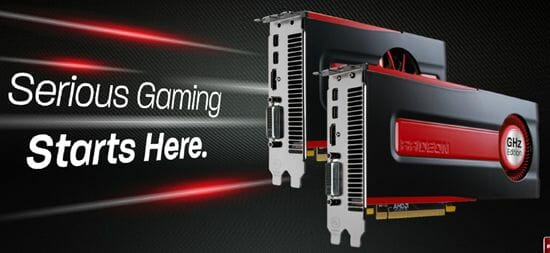
This implies that any graphics card from a lower class is not really meant for gamers. Well, this is an arguable point because it doesn’t agree with the fact that PC video games have not been very demanding in their system requirements lately, with but a few exception.
We are going to check out the new graphics cards with their Pitcairn GPUs that feature AMD’s Graphics Core Next microarchitecture and will compare their performance with same-class opponents.
Architecture and Positioning
Right now, AMD’s Southern Islands family is comprised of the Tahiti, Pitcairn and Cape Verde GPUs which are designed for top-end, midrange and low-end graphics cards, respectively.
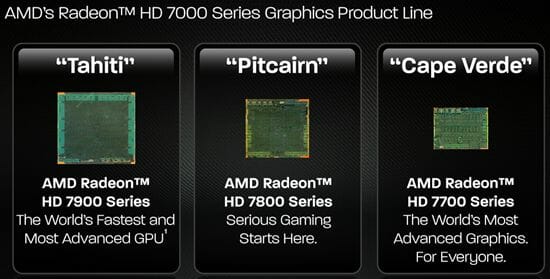
We’re already acquainted with the Tahiti-based Radeon HD 7970 and HD 7950 cards, so now we want to take a look at the Pitcairn which features the same Graphics Core Next microarchitecture.
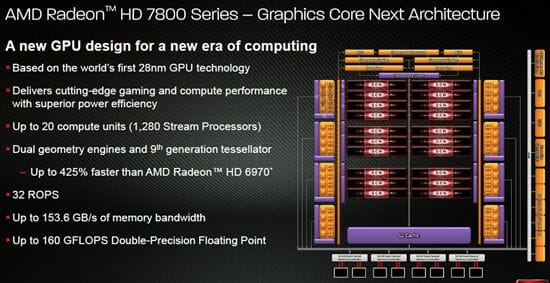
From a functional standpoint, the Pitcairn is no different from the Tahiti but has fewer unified shader processors (1280 and 1024 in the HD 7870 and HD 7850 as opposed to the HD 7950’s 1792) and fewer texture-mapping units (80 and 64 as compared to 112, respectively). The number of raster operators has remained the same at 32. Therefore the amount of transistors is reduced from 4313 to 2800 million whereas the die size is 212 rather than 365 sq. millimeters. That’s about all as to the architectural differences between the Pitcairn and the Tahiti.
Compared to its predecessors, the Radeon HD 7870 is up to 4.25 times as fast as the Radeon HD 6970 and also much faster than the GeForce GTX 570 and even GTX 580 in tessellation-heavy applications.
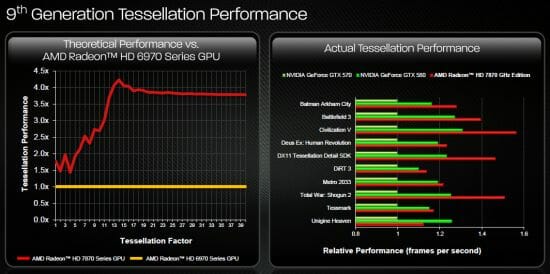
Besides the abovementioned architectural differences, the $100 gap between the Radeon HD 7870 and HD 7850 in recommended price is also due to their GPU clock rates: 1000 MHz for the HD 7870 and 860 MHz for the HD 7850.
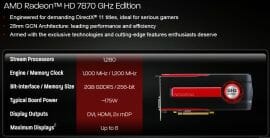
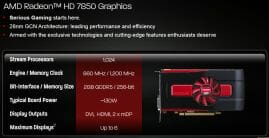
The HD 7850 is likely to be made out of GPUs that couldn’t be used for the HD 7870, so we can’t expect it to be very good at overclocking. However, AMD claims that the new graphics cards are both overclocker-friendly.
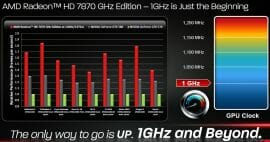
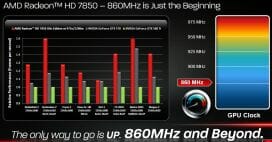
Energy efficiency being a hot topic nowadays, the typical power consumption of the Radeon HD 7870 is specified to be 175 watts (and up to 190 watts under peak load) whereas the HD 7850 consumes 130 watts (up to 150 watts under peak load). This is lower compared to the Radeon HD 6970’s 250 watts. The new cards need no more than 20 watts when idle and require a mere 3 watts when the monitor is turned off.
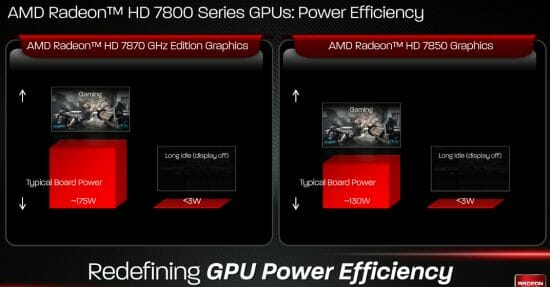
There’s nothing unusual about the new cards’ market positioning. Considering the price factor, the Radeon HD 7850 is supposed to compete with Nvidia’s GeForce GTX 560 Ti and GTX 570 whereas the Radeon HD 7870 is somewhere in between the GeForce GTX 570 and GTX 580.
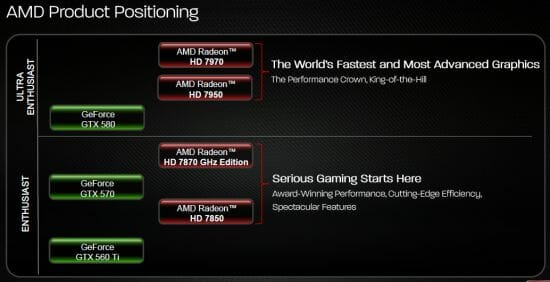
It’s somewhat different in practice, though, as you will learn shortly.
The new cards support morphological antialiasing version 2.0…
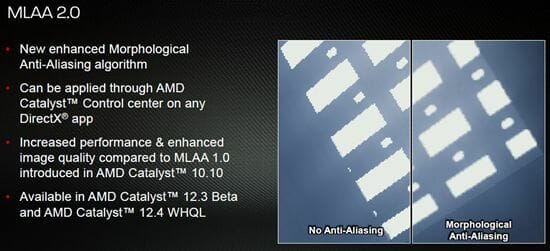
…and sparse grid supersample antialiasing which offers the highest image quality:
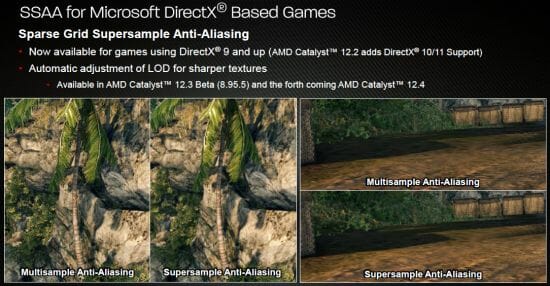
We don’t know if the Radeon HD 7870 and HD 7850 support the new antialiasing algorithms FXAA and TXAA.
The new cards’ specs are listed in the table in comparison with AMD’s Radeon HD 7950, Radeon HD 6970 and Radeon HD 6870:
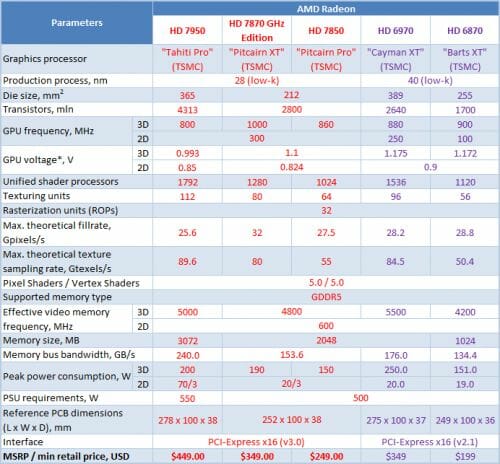
Closer Look at AMD Radeon HD 7870 GHz Edition and HD 7850 Graphics Cards
PCB Design
The reference Radeon HD 7870 GHz Edition and HD 7850 resemble top-end Tahiti-based products with their glossy black casing that has an eye-catching red insert in the center.
The cards are 252 millimeters long, which is 26 millimeters shorter than the reference HD 79xx. They are the same height (38 millimeters) and width (100 millimeters), though.
The reverse side of the PCB is open.We can see power connectors and one MIO connector for CrossFireX configurations.
Each card has the same selection of video interfaces: one dual-link DVI-I, one HDMI and two mini-DisplayPorts. There is also a vent grid in the mounting bracket for exhausting the hot air out of the system case.
The cards differing in their power consumption and heat dissipation, the Radeon HD 7870 comes with two 6-pin power connectors while the Radeon HD 7850 has only one such connector.
Each card has only one CrossFireX connector.The PCBs of the new cards resemble the reference Radeon HD 6870 and do not differ much from each other.
The power system is located between the video outputs and the GPU. It is 5+1+1 phases (GPU+memory+PLL) on the Radeon HD 7870. The HD 7850 has only 4 GPU power phases.
The power system is managed by a CHiL Semiconductor CHL8225 controller.The Pitcairn XT and Pro chips of our cards are almost the same age. The HD 7870’s GPU was manufactured on the 52nd week of 2011 while the HD 7850’s on the 51st week of 2011.
You can refer to the previous section of this review for details on the GPU specs.Each card is equipped with eight FCBGA-packaged chips of GDDR5 manufactured by Hynix Semiconductor. Labeled H5GQ2H24MFR T2C, they have a total capacity of 2 gigabytes.
Each card has the same memory clock rate of 4800 MHz in 3D mode. It is lowered to 600 MHz in 2D mode. The memory bus is 256 bits wide.The latest version of GPU-Z reports that our GPUs have a rather low quality level: 68.8% for the HD 7870 and 65.7% for the HD 7850.
Cooling System, Temperatures, Overclocking and Power Consumption
The cards have the same cooling system. Being far from innovative, the cooler consists of a plastic casing, a GPU heatsink and a metallic plate with blower.The metallic plate helps cool the power circuit components and memory chips via thermal pads.
Some of the components are directly cooled by the blower through the slits in the plate.As for the GPU heatsink, it consists of a solid copper base, copper heat pipes and aluminum fins which are soldered to the base and pierced by the pipes.
The two outermost heat pipes are 6 millimeters in diameter. The central pipe is 8 millimeters in diameter. All the elements are soldered to each other in this cooler.The 70mm fan is the same PVB070G12N model from Foxconn on both cards. It runs on a dual ball bearing.
The speed of the fan is PWM-regulated from 1000 to 5700 RPM. Fortunately, the fans never got higher than 2050 RPM during our tests.
We checked out the cards’ temperature while running Aliens vs. Predator (2010) in five cycles at the highest settings (2560×1600, with 16x anisotropic filtering and 4x antialiasing). We used MSI Afterburner 2.2.0 Beta 14 and GPU-Z 0.5.9 as monitoring tools. This test was carried out with a closed system case at an ambient temperature of 26°C. We didn’t change the cards’ default thermal interface.
Let’s see how efficient the coolers are with the fan regulated automatically and at the maximum speed.
So, the GPU temperature of the AMD Radeon HD 7870 was as high as 76°C in the automatic mode, the fan reaching a top speed of 2030 RPM. The HD 7850 was only 69°C hot at a speed of 1700 RPM. This might be expected considering the identical coolers and the cards’ GPU specs. When the fans worked at the maximum speed, the GPU temperature of each card was no higher than 51°C, but, of course, the fans were unbearably noisy at 5700 RPM. We don’t know the reason for AMD to have chosen such high-speed fans. A fan with a rated speed of 3000 RPM would be quite enough.
Then we measured the level of noise using an electronic noise-level meter CENTER-321 in a closed and quiet room about 20 sq. meters large. The noise-level meter was set on a tripod at a distance of 15 centimeters from the graphics card which was installed on an open testbed. The mainboard with the graphics card was placed at an edge of a desk on a foam-rubber tray.
The bottom limit of our noise-level meter is 29.8 dBA whereas the subjectively comfortable (not low, but comfortable) level of noise when measured from that distance is about 36 dBA. The speed of the graphics card’s fans was being adjusted by means of a controller that changed the supply voltage in steps of 0.5 V.
We’ve included the results of a reference AMD Radeon HD 7970 in the next diagram for the sake of comparison.
The cooling system installed on the Radeon HD 7870 and HD 7850 is quieter than the reference Radeon HD 7970 cooler as is indicated by the noise level graphs as well as by the vertical dotted lines which mark the speed range of the fans in the automatic regulation mode. It doesn’t mean that the new cards are really quiet, though. Each of them was audible against the background noise of our quiet testbed in 3D mode.
We tried to overclock our cards with their default coolers and at their default voltages. The Radeon HD 7870 was stable at a GPU clock rate of 1190 MHz (+19%) while the HD 7850, at 1050 MHz (+22.1%).
The memory chips of every card refused to be clocked higher than 5800 MHz, which is +21% to their default clock rate. Hopefully, off-the-shelf samples will be more overclocker-friendly.
The GPU temperature of the overclocked AMD Radeon HD 7870 grew by a mere 3°C, the top speed of the fan increasing from 2030 to 2200 RPM. The Radeon HD 7850 got hotter by 9°C and its fan accelerated by 370 RPM compared to the non-overclocked mode.
Next we measured the power consumption of computer systems with different graphics cards using a multifunctional panel Zalman ZM-MFC3 which can report how much power a computer (the monitor not included) draws from a wall socket. There were two test modes: 2D (editing documents in Microsoft Word and web surfing) and 3D (the benchmark from Metro 2033: The Last Refuge at 1920×1080 with maximum settings).
It’s clear that the systems with the new AMD Radeon HD 7870 and 7850 cards are the most economical ones, consuming no more than 425 watts even if the graphics card is overclocked. Take note that these two systems differ by a mere 5 watts from each other but the difference from the Radeon HD 7950 system is 30 watts. Of course, Nvidia’s solutions and AMD’s previous generation card need more power than AMD’s Tahiti and Pitcairn-based products.
Testbed Configuration and Testing Methodology
All graphics cards were tested in a system with the following configuration:
- Mainboard: Intel Siler DX79SI (Intel X79 Express, LGA 2011, BIOS 0453 from 03/15/2012);
- CPU: Intel Core i7-3960X Extreme Edition, 3.3 GHz, 1.2 V, 6 x 256 KB L2, 15 MB L3 (Sandy Bridge-E, C1, 32 nm);
- CPU cooler: Phanteks PH-TC14PE (2 x 135 mm fans at 900 RPM);
- Thermal interface: ARCTIC MX-4;
- System memory: DDR3 4 x 4GB Mushkin Redline (Spec: 2133 MHz / 9-11-10-28 / 1.65 V);
- Graphics cards:
- Sapphire Radeon HD 7950 OC 3 GB/384 bit GDDR5, 800/5000 MHz;
- Sapphire Radeon HD 6970 Dual Fan 2 GB/256 bit GDDR5, 880/5500 MHz;
- MSI N580GTX Lightning Xtreme Edition 3 GB/384 bit GDDR5, 772/1544/4008 MHz;
- Palit GeForce GTX 570 Sonic Platinum 1.28 GB/320 bit GDDR5, 732/1464/3800 MHz;
- AMD Radeon HD 7870 2 GB/256 bit GDDR5, 1000/4800 MHz and 1190/5800 MHz;
- AMD Radeon HD 7850 2 GB/256 bit GDDR5, 860/4800 MHz and 1050/5800 MHz;
- System drive: Crucial m4 256 GB SSD (SATA-III,CT256M4SSD2, BIOS v0009);
- Drive for programs and games: Western Digital VelociRaptor (300GB, SATA-II, 10000 RPM, 16MB cache, NCQ) inside Scythe Quiet Drive 3.5” HDD silencer and cooler;
- Backup drive: Samsung Ecogreen F4 HD204UI (SATA-II, 2 TB, 5400 RPM, 32 MB, NCQ);
- System case: Antec Twelve Hundred (front panel: three Noiseblocker NB-Multiframe S-Series MF12-S2 fans at 1020 RPM; back panel: two Noiseblocker NB-BlackSilentPRO PL-1 fans at 1020 RPM; top panel: standard 200 mm fan at 400 RPM);
- Control and monitoring panel: Zalman ZM-MFC3;
- Power supply: Xigmatek “No Rules Power” NRP-HC1501 1500 W (with a default 140 mm fan);
- Monitor: 30” Samsung 305T Plus.
On the AMD side, the newcomers will compete against the top Radeon HD 7950 with the frequencies adjusted to the nominal for this particular graphics cards and the previous generation leader – AMD Radeon HD 6970. Both products are manufactured by Sapphire:
On the Nvidia side, we will have GeForce GTX 580 3 GB from MSI and GeForce GTX 570 1.28 GB from Palit.As we can see, the frequencies of these graphics cards have also been adjusted to match the nominal values. Overall, our today’s test session will include 6 graphics accelerators, two of which were tested at the nominal as well as increased frequencies.
In order to lower the dependence of the graphics cards performance on the overall platform speed, I overclocked our 32 nm six-core CPU with the multiplier set at 37x, BCLK frequency set at 125 MHz and “Load-Line Calibration” enabled to 4.625 GHz. The processor Vcore was increased to 1.45 V in the mainboard BIOS.
Hyper-Threading technology was enabled. 16 GB of system DDR3 memory worked at 2 GHz frequency with 9-11-10-28 timings and 1.65V voltage.
The test session started on March 23, 2012. All tests were performed in Microsoft Windows 7 Ultimate x64 SP1 with all critical updates as of that date and the following drivers:
- Intel Chipset Drivers 9.3.0.1020 WHQL from 01/26/2011 for the mainboard chipset ;
- DirectX End-User Runtimes libraries from November 30, 2010;
- AMD Catalyst 12.2 driver from 03/07/2012 + Catalyst Application Profiles 12.2 (CAP1) from 01.18.2012 for AMD based graphics cards;
- Nvidia GeForce 296.10 WHQL from 03/13/2012 for Nvidia based graphics cards.
The graphics cards were tested in two resolutions: 1920×1080 and 2560×1600. The tests were performed in two image quality modes: “Quality+AF16x” – default texturing quality in the drivers with enabled 16x anisotropic filtering and “Quality+ AF16x+MSAA 4(8)x” with enabled 16x anisotropic filtering and full screen 4x anti-aliasing (MSAA) or 8x if the average framerate was high enough for comfortable gaming experience. We enabled anisotropic filtering and full-screen anti-aliasing from the game settings. If the corresponding options were missing, we changed these settings in the Control Panels of Catalyst and GeForce drivers. We also disabled Vsync there. There were no other changes in the driver settings.
The list of games and applications used in this test session includes two popular semi-synthetic benchmarking suites, one technical demo and 15 games of various genres:
- 3DMark Vantage (DirectX 10) – version 1.0.2.1, Performance and Extreme profiles (only basic tests);
- 3DMark 2011 (DirectX 11) – version 1.0.3.0, Performance and Extreme profiles;
- Unigine Heaven Demo (DirectX 11) – version 3.0, maximum graphics quality settings, tessellation at “extreme”, AF16x, 1280×1024 resolution with MSAA and 1920×1080 with MSAA 8x;
- S.T.A.L.K.E.R.: Call of Pripyat (DirectX 11) – version 1.6.02, Enhanced Dynamic DX11 Lighting profile with all parameters manually set at their maximums, we used our custom cop03 demo on the Backwater map;
- Left 4 Dead 2 (DirectX 9) – version 2.1.0.0, maximum graphics quality settings, proprietary d98 demo (two runs) on “Death Toll” map of the “Church” level;
- Metro 2033: The Last Refuge (DirectX 10/11) – version 1.2, maximum graphics quality settings, official benchmark, “High” image quality settings; tesselation, DOF and MSAA4x disabled; AAA aliasing enabled, two consecutive runs of the “Frontline” scene;
- Just Cause 2 (DirectX 11) – version 1.0.0.2, maximum quality settings, Background Blur and GPU Water Simulation disabled, two consecutive runs of the “Dark Tower” demo;
- Aliens vs. Predator (2010) (DirectX 11) – Texture Quality “Very High”, Shadow Quality “High”, SSAO On, two test runs in each resolution;
- Lost Planet 2 (DirectX 11) – version 1.0, maximum graphics quality settings, motion blur enabled, performance test “B” (average in all three scenes);
- StarCraft 2: Wings of Liberty (DirectX 9) – version 1.4.3, all image quality settings at “Extreme”, Physics at “Ultra”, reflections On, two 2-minute runs of our own “bench2” demo;
- Sid Meier’s Civilization V (DirectX 11) – version 1.0.1.348, maximum graphics quality settings, two runs of the “diplomatic” benchmark including five heaviest scenes;
- Tom Clancy’s H.A.W.X. 2 (DirectX 11) – version 1.04, maximum graphics quality settings, shadows On, tessellation Off (not available on Radeon), two runs of the test scene;
- Total War: Shogun 2 (DirectX 11) – version 2.0, built in benchmark (Sekigahara battle) at maximum graphics quality settings;
- Crysis 2 (DirectX 11) – version 1.9, we used Adrenaline Crysis 2 Benchmark Tool v.1.0.1.13. BETA with “Ultra High” graphics quality profile and activated HD textures, two runs of a demo recorded on “Times Square” level;
- DiRT 3 (DirectX 11) – version 1.2, built-in benchmark at maximum graphics quality settings on the “Aspen” track;
- Hard Reset Demo (DirectX 9) – benchmark built into the demo version with Ultra image quality settings, one test run;
- Batman: Arkham City (DirectX 11) – version 1.2, maximum graphics quality settings, physics disabled, two sequential runs of the benchmark built into the game.
- Battlefield 3 (DirectX 11) – version 1.3, all image quality settings set to “Ultra”, two successive runs of a scripted scene from the beginning of the “Going Hunting” mission 110 seconds long.
If the game allowed recording the minimal fps readings, they were also added to the charts. We ran each game test or benchmark twice and took the best result for the diagrams, but only if the difference between them didn’t exceed 1%. If it did exceed 1%, we ran the tests at least one more time to achieve repeatability of results.
Performance
The graphics cards are listed in the diagrams in the order of descending retail price:
- Radeon HD 7950 – starting at $449;
- GeForce GTX 580 1.5 GB/3 GB – starting at $389/starting at $529;
- Radeon HD 7870 – starting at $359;
- Radeon HD 6970 – starting at $349;
- GeForce GTX 570 – starting at $289;
- Radeon HD 7850 – starting at $249.
3DMark Vantage
The standings from the cheapest Radeon HD 7850 to the most expensive Radeon HD 7950 match the recommended prices of the cards. And while the HD 7850 doesn’t show anything exceptional, the HD 7870 beats the Radeon HD 6970. When overclocked, it even has the highest score among all the cards, including the GTX 580 and HD 7950. That’s very good for a $349 product!
3DMark 2011
The new cards from AMD look even better in the heavier tests of 3DMark 2011.
Unigine Heaven Demo
AMD’s new products are especially impressive in this test. As you remember, AMD has promised a fourfold increase in their tessellation performance!
S.T.A.L.K.E.R.: Call of Pripyat
The Radeon HD 7870 GHz Edition and Radeon HD 7850 perform brilliantly in our first gaming test. They beat the Radeon HD 6970 as well as the GeForce GTX 580 and GTX 570. The overclocked Radeon HD 7870 even outperforms the Radeon HD 7950!
Left 4 Dead 2
The new cards are impressively fast in this game, too.
Metro 2033: The Last Refuge
The Metro 2033 game engine calls for a faster graphics subsystem, so you can play comfortably only at 1920×1080 unless you lower your visual quality settings. There’s no point in comparing the cards as they differ by a mere 2 or 3 frames per second.
Aliens vs. Predator (2010)
We’ve got the same standings in Just Cause 2 and Aliens vs. Predator (2010). The performance of each card corresponds to its recommended price more or less accurately.
Lost Planet 2
Being traditionally strong in Lost Planet 2, the green team is challenged by the overclocked reds which are also ahead of the violets.
StarCraft II: Wings of Liberty
The AMD cards would be good compared to the GeForce GTX series in this game if it were not for their terrible performance with turned-on antialiasing.
Sid Meier’s Civilization V
The new cards from AMD strike back in this game, though:
Tom Clancy’s H.A.W.X. 2
It’s hard to beat Nvidia’s solutions in this game, yet the overclocked Radeon HD 7870 GHz Edition and HD 7850 can do that. Moreover, the Radeon HD 7870 is occasionally ahead of the Radeon HD 7950 even at the default clock rates whereas the Radeon HD 7850 is always ahead of the Radeon HD 6970.
Total War: Shogun 2
Crysis 2
Total War: Shogun 2 and Crysis 2 are among the most resource-consuming 3D games, especially at high resolutions where they need a lot of graphics memory. The new cards from AMD can successfully compete with the GeForce GTX 570 and 580 here whereas the Radeon HD 7870 model can even challenge the Radeon HD 7950.
DiRT 3
The DiRT 3 results agree with what we’ve seen in the previous tests.
Battlefield 3
It’s hard to analyze such a large amount of data. Let’s do it with the help of summary diagrams in the next section of our review.
Performance Summary Diagrams
The first pair of diagrams shows how faster the AMD Radeon HD 7870 GHz Edition is in comparison with its junior cousin Radeon HD 7850.
The Radeon HD 7870 GHz Edition is an average 18-20% ahead of the HD 7850 at 1920×1080 and 19-23% ahead at 2560×1600 across all the tests. The Radeon HD 7870 is supposed to be 40% more expensive according to the recommended price. So, we wonder if the Radeon HD 7850 overclocked to 1050/5800 MHz can match the reference Radeon HD 7870 GHz Edition? The next couple of summary diagrams answer this question.
Indeed, the overclocked Radeon HD 7850 can challenge the Radeon HD 7870 GHz Edition and even beat the latter in many games! It means you can get the performance of the senior card for the junior model’s price.
Well, the Radeon HD 7870 GHz Edition is a real bargain in its own right. First, it is not much slower than the more expensive Radeon HD 7950 at the default frequencies: by an average 6.5-11.5% at 1920×1080 and by an average 11-13% at 2560-1600.
And when the Radeon HD 7870 GHz Edition is overclocked to 1190/5800 MHz, it beats the HD 7950 in all but three games and a half.
Thus, the overclocked Radeon HD 7870 GHz Edition is 4-8% ahead of the more expensive reference Radeon HD 7950 at 1920×1080 and 3-5% ahead of it at 2560×1600.
Finally, let’s make two more comparisons. First, the new AMD Radeon HD 7870 GHz Edition vs. Nvidia’s ex-flagship GeForce GTX 580 3GB.
The GeForce GTX 580 wins more tests, just as expected. However, the gap from the Radeon HD 7870 is not large on average: a mere 4-11% at 1920×1080 and 2-11% at 2560×1600. And the Radeon HD 7870 can bridge the gap altogether when overclocked (except for the antialiasing mode in StarCraft II). But the GeForce GTX 580 can be overclocked as well, so we only compare them at their default clock rates.
And now let’s compare the AMD Radeon HD 7850 with the NVIDIA GeForce GTX 570.The Nvidia-based card enjoys a larger advantage here: 9-12% at 1920×1080 and 8-10% at 2560×1600. And again, the Radeon can bridge the gap if overclocked (to 1050/5800 MHz).
Conclusion
AMD’s new mainstream graphics cards, Radeon HD 7870 GHz Edition and Radeon HD 7850, can deliver the same performance (and even more if you overclock them) than the single-GPU top-end cards of the previous generations. Moreover, they have lower recommended prices than the current retail prices of the Radeon HD 6970 and GeForce GTX 580 1.5GB. Pricing is a crucial factor, but we guess that AMD’s new products would be true bestsellers if they were some $50 cheaper…
Thanks to the new PowerTune and ZeroCore Power technologies they can boast high energy efficiency both in 3D and 2D modes. They are compact and offer all popular video interfaces.
We think that these cards will be most demanded in their pre-overclocked versions which are already supplied by many brands. The high overclocking potential of the 28nm Pitcairn GPUs coupled with the high-efficiency coolers from ASUS, Sapphire, MSI or Gigabyte can make them even more competitive and attractive. In fact, the AMD Radeon HD 7870 GHz Edition and HD 7850 have no real competitors in their price categories right now, but we hope that Nvidia will change this situation soon, driving the prices even lower. This hasn’t yet happened to the AMD Radeon HD 7970 after the recent release of the Nvidia GeForce GTX 680, but we’re still waiting…